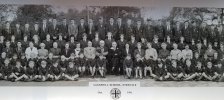Howard Newman
Brummie babby
Printing the whole of the school photograph in a much smaller size would make the people unrecognizable. Therefore, the attached photograph of the central portion is a compromise - apologies to the rest of the 216 students that did not make the cut.
At centre is the Head Master, R. A. F. Newton-Hearn and to his left (stage right) is Ward-Davis and next to him is Lt. Col. P. J. Gething MC. Next is Miss Young - which wasn't her 'real' name as she was married and had a daughter who attended the school and is also in the photograph. Miss Young taught English Grammar and Literature and was influential in expanding my interest in fiction, beyond curriculum required The History of Mr. Polly, by lending me her own Penguin paperback. To her left is Miss Diaper, Mathematics, and then Facilities Maintenance. When a wasp flew into the main corridor of the school, I demonstrated my leadership potential by smacking it against a window with my bare hand. Dad was requested to provide the pane and Maintenance installed it. Next left is, I think, Kitchen Staff and Cook.
Early on in the pandemic, when I was endeavouring to reduce my accumulation of half a century's priceless memorabilia (a.k.a. 'stuff'), I reviewed this photograph and wondered what had happened to the boy to my left, two along from Cook. Being out of the country, the search took a while but eventually I was greatly saddened to learn that my inquiries were started much too late.

At centre is the Head Master, R. A. F. Newton-Hearn and to his left (stage right) is Ward-Davis and next to him is Lt. Col. P. J. Gething MC. Next is Miss Young - which wasn't her 'real' name as she was married and had a daughter who attended the school and is also in the photograph. Miss Young taught English Grammar and Literature and was influential in expanding my interest in fiction, beyond curriculum required The History of Mr. Polly, by lending me her own Penguin paperback. To her left is Miss Diaper, Mathematics, and then Facilities Maintenance. When a wasp flew into the main corridor of the school, I demonstrated my leadership potential by smacking it against a window with my bare hand. Dad was requested to provide the pane and Maintenance installed it. Next left is, I think, Kitchen Staff and Cook.
Early on in the pandemic, when I was endeavouring to reduce my accumulation of half a century's priceless memorabilia (a.k.a. 'stuff'), I reviewed this photograph and wondered what had happened to the boy to my left, two along from Cook. Being out of the country, the search took a while but eventually I was greatly saddened to learn that my inquiries were started much too late.


